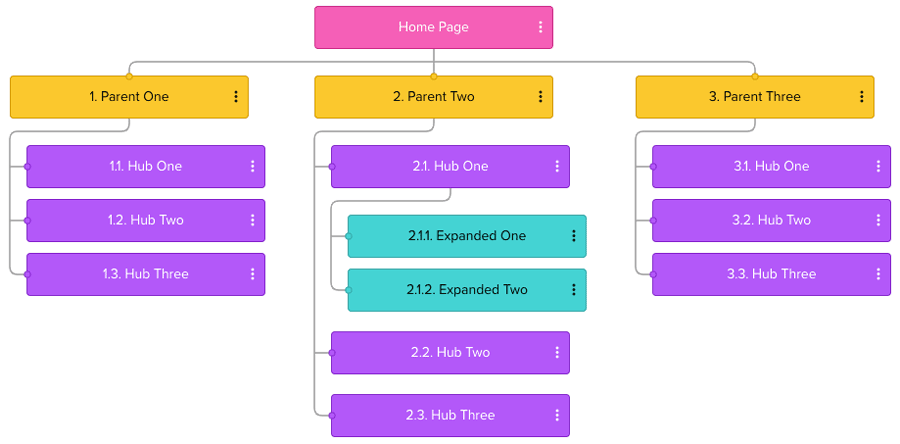Website silo structure SEO is a system of organizing a website’s architecture among web pages that group content related to a particular topic within a website’s sitemap. These pages are set up in a hierarchy, from general to specific in top to bottom fashion.
It’ll make more sense as we go along but to cut a long story short, the whole point of silo architecture is to make your entire site easy to navigate. To have a logical and orderly flow so that visitors don’t need a lot of time to learn how to get around.
Picture being in a mall, for example, and finding out that the bathrooms are on the roof for some reason. Who put them there? Why? Like, really, why? How is that convenient for anyone? How do I even get there?
You don’t want people getting to your website and three seconds later being focused on how confusing it is because while they might stay in a mall, they most certainly won’t stay on your site when others are just a click away.
More importantly, web crawlers understand silos and how to index them exceedingly well so you can be confident that your pages will climb the search engine rankings and pop up when someone punches in a relevant keyword.
Optimizing page hierarchy in a website silo structure
The key to nailing website silo structure and the hierarchy of your pages is really an exercise in combining like with like and then separating each distinct category from the rest. Building out categories and then breaking those down into subcategories of increasingly more specific information and content.
Plenty of things we know and love use some version of a silo to make things easier. Take football for instance; at the top level you have the NFL as a whole, then you have the AFC and the NFC and from there it breaks down regionally to AFC North, NFC South, etc.

Websites, the best ones, all work from a similar principle.
Starting from the home page, typically the parent/hub page will have its own navigation to the underlying child/detail pages within a silo and the thing that elevates user experience is the clarity with which this is done. Visitors to any website have an underlying assumption that the deeper they go into a site the more pertinent to the main keyword or category the content becomes.
It’s just how our brains work and when implemented correctly the user journey will feel like it’s starting to shape itself. Almost like magic.
Users trust that they can easily follow the silo navigation from one page to the next and that each successive layer of content will be even more highly specific.
Good content silos will contain between 4-10 pages of content; any less and you run the risk of being too shallow on a topic, losing search relevance and user attention in the process. The easiest solution is to either add more content or further divide topics from your current silo pages into new pages.
On the other side of the spectrum, more than 10 pages becomes cumbersome for the user, and quite frankly, annoying. You generally don’t need 10+ pages on a subject and chances are a user will lose interest with every click down that rabbit hole. A good option in this case is to either reduce or combine topics or even break them out into a new silo if there’s enough.
A dedicated sitemap creator goes a long way in helping you keep your silos manageable.
🎬 Learn what Slickplan can do!
We filmed a short video to show you exactly how to use Slickplan
SEO silo structure example:
In this SEO silo structure example, super-duper-office-chairs.com sells a veritable cornucopia of chairs for the office. All of which are super, of course. Excellent reviews.

They have a lot of different styles, each with their own unique features and pros & cons. To better educate their visitors about said chairs, the company created additional content as part of their website planning to laser focus on each type as well as answer common questions.
To do this, they used an indexed hierarchy, or website siloed architecture approach, for laying out their new pages.
1. Initial parent/hub silo pages

Super-duper started by creating parent/hub pages as initial silo pages. These give a proper introduction about the different types of chairs they offer and a summary of the underlying subject matter with navigation being informed by the sitemap design so users can easily jump to subtopics and quickly find the information they’re there for.
2. Supporting pages for further SEO siloing

Next, Super-duper built a set of pages beneath the parent/hub page for further SEO siloing, addressing unique and individual topics relevant to the overall theme of office chairs. They strategically utilized internal links and descriptive anchor text to describe exactly where the users go upon clicking.
Topics included a mix of product, philosophy, research and opinions to give the reader a deeper diver into each product line or concept.
3. Expanding the silo structure SEO

Six months later, Super-duper decided to add desks to their product line (go big or go home) and extend the silo site structure further. Because of prior planning in their initial website development and a commitment to siloing, when it came time to add new content to educate their visitors, their site architecture readily supported scalability for the new desk silo.
The prep work to start out with a solid foundation meant they saved time and money by avoiding a site wide navigation redesign.
Importantly, from a search engine optimization standpoint, this also meant expanding their link structure and cross-linking which gave their pages and website more authority.
View a silo SEO structure demo
Breaking your website content down into a silo SEO structure is as easy as separating the pogs from the slammers, the curds from the whey, the Green Day licks from the Guns N’ Roses solos, etc.
On top of helping your visitors get where they want to go with as little friction as possible, specialized page content ranks better and therefore tends to come up in search results more frequently.
Slickplan can help you simplify and streamline your site structure in minutes. Try for free!
Silo structure SEO benefits
Silo structure SEO benefits run the gamut from being the backbone of silky smooth navigation to keeping users engaged to ensuring that relevant pages are easy to find and beyond.
SEO silos create better user experiences

Less learning curve = more positive affinity
When the stars align and information architecture best practices are used properly to create superb SEO silos, a visitor to your website just isn’t required to do as much thinking to understand how content is organized.
The goal is for users to quickly find what they’re looking for with minimal frustration, leaving them with positive affinity toward your site. Or, in the parlance of IG; #PositiveVibesOnly
Because this style of organization is so common to things outside of websites it’s immediately recognizable, meaning that these silos, or content groups, influence user behavior by making movement infinitely more intuitive.
No need to reinvent the wheel and certainly no need to turn it into some weird rhombus that makes the ride unnecessarily bumpy.
Increase time on a site, decrease bounce rates
Simple math:
Quality content + instinctive navigation = more time spent on your site
For real.
Using the time-honored silo technique means you’re playing into the fact that netizens genuinely understand that content gets more focused and narrow the deeper they click.
It would be an odd move to put your product listings in your service pages menu…because, ya know, it makes no sense. You know it just by reading it and you’ll bounce users, and potential conversions, by doing it.
Keep in mind that a user can realistically land anywhere in a given silo, from top to bottom, depending on how they arrive there; be it site navigation, a search engine query using target keywords, an ad, a link on a forum, a blog post, etc. Given that, it’s imperative to quickly have your users understand where they are geographically within the silo and how to get around without leaving the site.
You make this happen by incorporating readily-accessible, clear navigation menus or breadcrumbs which highlight the user’s current location on the site as well as how to get back to the homepage, the top page of the silo or over to other silos with ease.
Silo structures are optimal for SEO
Organization leads to optimization and a silo structure is the premiere option for getting your site whipped into top SEO shape.

More landing page visitors
By creating silo structures and dedicated pages for important topics, you’ll gain additional chances to rank for related keywords on search engines. In turn, these pages can each become powerful landing pages or entry points into your site.
Increased relevance of general topics
Like a well organized file cabinet, by grouping your topics into a hierarchy as part of the sitemap design, a search engine can more effectively understand which content goes with which other content and direct people to it. This leads to a greater potential for a hub page to rank for a general keyword due to its association with, and traffic from, the underlying – and interlinked – page topics.
The cherry on top of the SEO sundae; with increased relevance for your target keywords, it’s possible that your search ranking can also increase for related search terms.
URL silo website structure optimization for query synonyms
In conjunction with knowing how to plan a website architecture, simplifying keyworded URLs so that the parent page is the URL folder root and the child pages follows brings the important keywords together in the same URL.

If a supporting page relates specifically to a given child page, you can add an additional level but you’ll want to use this tactic sparingly to both limit the number of pages in your silo and, crucially, to avoid confusion.
Also, stay away from duplicating keywords in the same URLs. When you’re down at this level of detail, you might as well maximize the effort and do it right. Reference your keyword research to find high value alternative ways to say the same thing so that you cover the broadest range of keyword queries possible.
The idea here is to be able to cast a wide net and be recognized as relevant for as many search variations as you can.
Design user-friendly sites with Slickplan
Use our easy drag-and-drop interface to ensure people can get where they want to go.
Silo architecture & design makes content planning easier
Here’s the thing; siloed architecture works.
It just does and that’s because it aligns snuggly with what we already expect from a website.
In fact, if you find a better architecture out there let us know because we’ve got a bridge we can sell you.
Not only does it enhance the navigability of your site but it makes your content planning a helluva lot easier, particularly if you establish it in the beginning of the development process. Being able to start from a blank slate, big picture view helps you group related content from the outset rather than forcing it to fit within your existing structure.







 X
X

